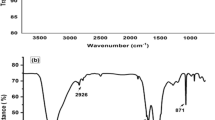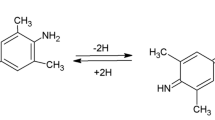Abstract
ZnO nanorods and graphene foam were synthesized via hydrothermal synthesis and chemical vapor deposition, respectively. Hybrid of ZnO nanorods and graphene nanosheets was prepared by ultrasonic treatment. The hybrid was sprayed onto the ITO glass. The hybrid was characterized by scanning electron microscopy, X-ray diffraction, and Raman spectroscopy. The electrochemical properties of the hybrid were measured by cyclic voltammetry and differential pulse voltammetry. The results show that the diameter and length of ZnO nanorods are ~ 50 nm and 5 μm, respectively. Graphene nanosheets with high quality are made up of few layers and the sheet size is ~ 2 μm. The sensitivity of the hybrid for detection of uric acid is 0.3 μM μA−1 cm−2 in the range of 5~80 μM. The electrode can accurately detect uric acid in the presence of ascorbic acid. Meanwhile, the electrode also shows good repeatability and stability.











Similar content being viewed by others
References
Haas BR, Stewart TH, Zhang J (2012) Premotor biomarkers for Parkinson’s disease-a promising direction of research. Transl Neurodegener 1(1):11–12. https://doi.org/10.1186/2047-9158-1-11
Ping J, Wu J, Wang Y, Ying Y (2012) Simultaneous determination of ascorbic acid, dopamine and uric acid using high-performance screen-printed graphene electrode. Biosens Bioelectron 34(1):70–76. https://doi.org/10.1016/j.bios.2012.01.016
Beitollahi H, Ardakani MM, Naeimi H et al (2009) Electrochemical characterization of 2, 2′-[1, 2-ethanediylbis (nitriloethylidyne)]-bis-hydroquinone-carbon nanotube paste electrode and its application to simultaneous voltammetric determination of ascorbic acid and uric acid. J Solid State Electrochem 13(3):353–363. https://doi.org/10.1007/s10008-008-0553-z
Shahrokhian S, Zare-Mehrjardi HR, Khajehsharifi H (2009) Modification of carbon paste with congo red supported on multi-walled carbon nanotube for voltammetric determination of uric acid in the presence of ascorbic acid. J Solid State Electrochem 13(10):1567–1575. https://doi.org/10.1007/s10008-008-0733-x
Thiagarajan S, Chen SM (2007) Preparation and characterization of PtAu hybrid film modified electrodes and their use in simultaneous determination of dopamine, ascorbic acid and uric acid. Talanta 74(2):212–222. https://doi.org/10.1016/j.talanta.2007.05.049
Zhang A, Zheng G, Lieber C M (2016) General synthetic methods/nanowires. Springer International Publishing, pp 15–37
Yao BD, Chan YF, Wang N (2002) Formation of ZnO nanostructures by a simple way of thermal evaporation. Appl Phys Lett 81(4):757–759. https://doi.org/10.1063/1.1495878
Verma KK, Sinha RK, Sahay PP (2016) Structural. Optical and ethanol gas-sensing properties of zinc oxide thin film prepared by spray pyrolysis technique using ultrasonic nebuliser. Indian J Pure Appl Phys 51(11):765–768
Wang XH, Huang LQ, Niu LJ, Li RB, Fan DH, Zhang FB, Chen ZW, Wang X, Guo QX (2015) The impacts of growth temperature on morphologies, compositions and optical properties of Mg-doped ZnO nanomaterials by chemical vapor deposition. J Alloys Compd 622:440–445. https://doi.org/10.1016/j.jallcom.2014.10.077
Wang J, Yang P, Wei X (2015) High-performance, room-temperature, and no-humidity-impact ammonia sensor based on heterogeneous nickel oxide and zinc oxide nanocrystals. ACS Appl Mater Interfaces 7(6):3816–3824. https://doi.org/10.1021/am508807a
Wang LW, Wu F, Tian DX, Li WJ, Fang L, Kong CY, Zhou M (2015) Effects of Na content on structural and optical properties of Na-doped ZnO thin films prepared by sol-gel method. J Alloys Compd 623:367–373. https://doi.org/10.1016/j.jallcom.2014.11.055
Kuo CL, Kuo TJ, Huang MH (2005) Hydrothermal synthesis of ZnO microspheres and hexagonal microrods with sheetlike and platelike nanostructures. J Phys Chem B 109(43):20115–20121. https://doi.org/10.1021/jp0528919
Jamshidi M, Ghaedi M, Dashtian K, Hajati S, Bazrafshan AA (2016) Sonochemical assisted hydrothermal synthesis of ZnO: Cr nanoparticles loaded activated carbon for simultaneous ultrasound-assisted adsorption of ternary toxic organic dye: derivative spectrophotometric, optimization, kinetic and isotherm study. Ultrason Sonochem 32:119–131. https://doi.org/10.1016/j.ultsonch.2016.03.004
Lim CT (2013) Synthesis, optical properties, and chemical-biological sensing applications of one-dimensional inorganic semiconductor nanowires. Prog Mater Sci 58:705–748
Wang ZL, Song JH (2006) Piezoelectric nanogenerators based on zinc oxide nanowire arrays. Science 312(5771):242–246. https://doi.org/10.1126/science.1124005
Yue HY, Huang S, Chang J, Heo C, Yao F, Adhikari S, Gunes F, Liu LC, Lee TH, Oh ES, Li B, Zhang JJ, Huy TQ, Luan NV, Lee YH (2014) ZnO nanowire arrays on 3D hierachical graphene foam biomarker detection of Parkinson’s disease. ACS Nano 8(2):1639–1646. https://doi.org/10.1021/nn405961p
Zhang F, Wang X, Ai S, Sun Z, Wan Q, Zhu Z, Xian Y, Jin L, Yamamoto K (2004) Immobilization of uricase on ZnO nanorods for a reagentless uric acid biosensor. Anal Chim Acta 519(2):155–160. https://doi.org/10.1016/j.aca.2004.05.070
Brazhe RA, Kochaev AI (2012) Flexural waves in graphene and 2D supercrystals. Phys Solid State 54(8):1612–1614. https://doi.org/10.1134/S1063783412080069
Wu ZS, Ren W, Gao L, Zhao J, Chen Z, Liu B, Tang D, Yu B, Jiang C, Cheng HM (2009) Synthesis of graphene sheets with high electrical conductivity and good thermal stability by hydrogen arc discharge exfoliation. ACS Nano 3(2):411–417. https://doi.org/10.1021/nn900020u
Zhou M, Zhai Y, Dong S (2009) Electrochemical sensing and biosensing platform based on chemically reduced graphene oxide. Anal Chem 81(14):5603–5613. https://doi.org/10.1021/ac900136z
Dong X, Wang X, Wang L, Song H, Zhang H, Huang W, Chen P (2012) 3D graphene foam as a monolithic and macroporous carbon electrode for electrochemical sensing. ACS Appl Mater Interfaces 4(6):3129–3133. https://doi.org/10.1021/am300459m
Bonaccorso F, Colombo L, Yu G, Stoller M, Tozzini V, Ferrari AC, Ruoff RS, Pellegrini V (2015) Graphene, related two-dimensional crystals, and hybrid systems for energy conversion and storage. Science 347(6217):1246501. https://doi.org/10.1126/science.1246501
Georgakilas V, Tiwari JN, Kemp KC, Perman JA, Bourlinos AB, Kim KS, Zboril R (2016) Noncovalent functionalization of graphene and graphene oxide for energy materials: biosensing, catalytic, and biomedical applications. Chem Rev 116(9):5464–5519. https://doi.org/10.1021/acs.chemrev.5b00620
Lee S, Bong S, Ha J, Kwak M, Park SK, Piao Y (2015) Electrochemical deposition of bismuth on activated graphene-nafion composite for anodic stripping voltammetric determination of trace heavy metals. Sensors Actuators B 215:62–69. https://doi.org/10.1016/j.snb.2015.03.032
Nguyen NN, Jo SB, Lee SK, Sin DH, Kang B, Kim HH, Lee H, Cho K (2015) Atomically thin epitaxial template for organic crystal growth using graphene with controlled surface wettability. Nano Lett 15(4):2474–2484. https://doi.org/10.1021/nl504958e
Wei B, Wang L, Miao Q, Yuan Y, Dong P, Vajtai R, Fei W (2015) Fabrication of manganese oxide/three-dimensional reduced graphene oxide composites as the supercapacitors by a reverse microemulsion method. Carbon 85:249–260. https://doi.org/10.1016/j.carbon.2014.12.063
Lin S, Dong L, Zhang J, Lu H (2016) Room-temperature intercalation and 1000-fold chemical expansion for scalable preparation of high-quality graphene. Chem Mater 28(7):2138–2146. https://doi.org/10.1021/acs.chemmater.5b05043
Zhang JJ, Guo EJ, Yue HY, Wang LP, Zhang CY (2014) Effect of ultrasonic treatment before and after hydrothermal process on the morphologies and formation mechanism of ZnO nanorods. Appl Phys A 114(2):521–528. https://doi.org/10.1007/s00339-013-7604-8
Suk JW, Lee WH, Kang TJ, Piner RD (2016) Transfer of chemical vapor deposition-grown monolayer graphene by alkane hydrocarbon. Sci Adv Mater 8(1):144–147. https://doi.org/10.1166/sam.2016.2618
Thodkar K, El Abbassi M, Lüönd F et al (2016) Comparative study of single and multi domain CVD graphene using large-area Raman mapping and electrical transport characterization. Phys Status Solidi 10:807–811
Hou SF, Kasner ML, Su SJ et al (2010) Highly sensitive and selective dopamine biosensor fabricated with silanized graphene. J Phys Chem C 114(35):14915–14921. https://doi.org/10.1021/jp1020593
Kumar SA, Cheng HW, Chen SM (2009) Selective detection of uric acid in the presence of ascorbic acid and dopamine using polymerized luminol film modified glassy carbon electrode. Electroanalysis 21(20):2281–2286. https://doi.org/10.1002/elan.200904677
Ni F, Wang Y, Zhang D, Gao F, Li M (2010) Electrochemical oxidation of epinephrine and uric acid at a layered double hydroxide film modified glassy carbon electrode and its application. Electroanalysis 22(10):1130–1135. https://doi.org/10.1002/elan.200900530
Lotus AF (2009) Synthesis of semiconducting ceramic nanofibers, development of PN junctions, and bandgap engineering by electrospinning. The University of Akron, pp 141–143
Luo YC, Do JS, Liu CC (2006) An amperometric uric acid biosensor based on modified Ir-C electrode. Biosens Bioelectron 22(4):482–488. https://doi.org/10.1016/j.bios.2006.07.013
Rawal R, Chawla S, Chauhan N, Dahiya T, Pundir CS (2012) Construction of amperometric uric acid biosensor based on uricase immobilized on PBNPs/cMWCNT/PANI/Au composite. Int J Biol Macromol 50(1):112–118. https://doi.org/10.1016/j.ijbiomac.2011.10.002
Acknowledgements
This work is supported by the Natural Science Foundation of Heilongjiang Province (LC2015020), Technology Foundation for Selected Overseas Chinese Scholar, Ministry of Personnel of China (2015192), the Innovative Talent Fund of Harbin City (2016RAQXJ185), Science Funds for the Young Innovative Talents of HUST (201604), and Doctoral Scientific Research Fund of Heilongjiang Institute of Technology (2014BJ14).
Author information
Authors and Affiliations
Corresponding author
Additional information
Highlights
1. Novel hybrid of ZnO nanorods-graphene nanosheets was prepared.
2. The hybrid demonstrates a high sensitivity of 0.3 μA μM−1 cm−2 for the detection of uric acid.
3. The hybrid has excellent selectivity to determine uric acid in the presence of ascorbic acid.
Rights and permissions
About this article
Cite this article
Wang, Q., Yue, H., Zhang, J. et al. Electrochemical determination of uric acid in the presence of ascorbic acid by hybrid of ZnO nanorods and graphene nanosheets. Ionics 24, 2499–2507 (2018). https://doi.org/10.1007/s11581-017-2379-0
Received:
Revised:
Accepted:
Published:
Issue Date:
DOI: https://doi.org/10.1007/s11581-017-2379-0




